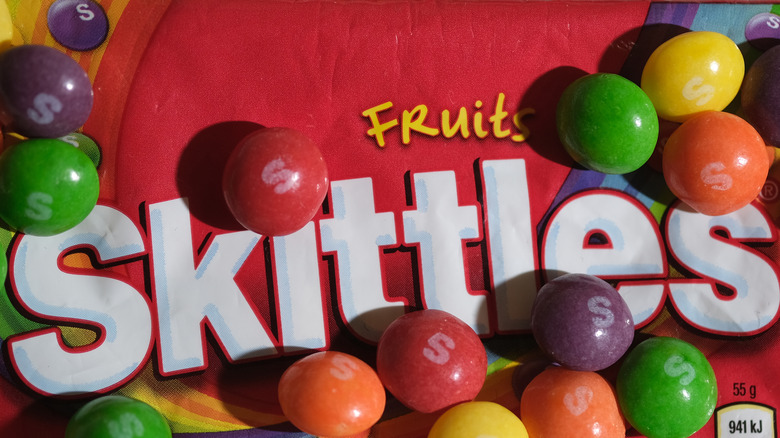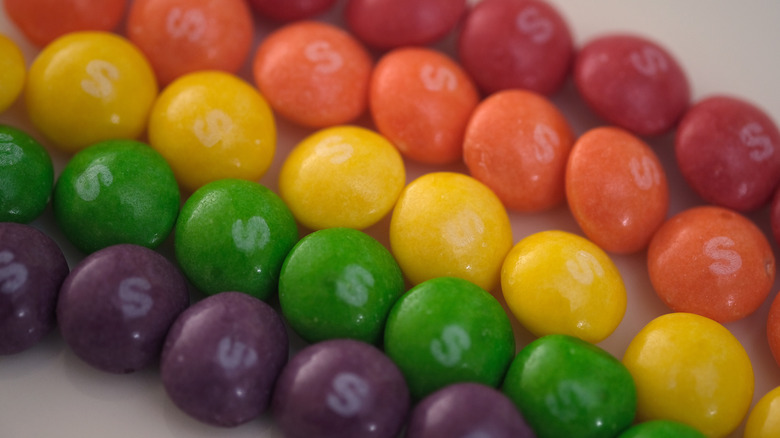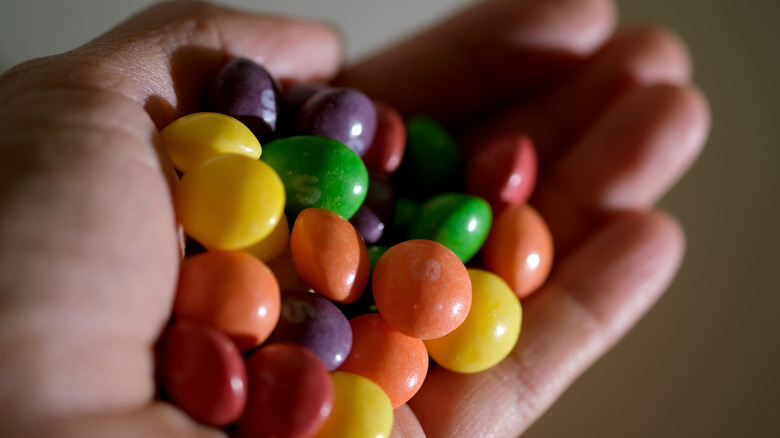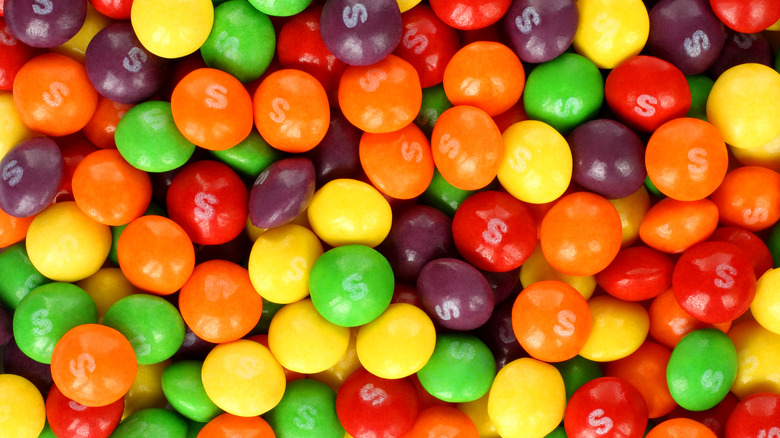All Kinds of Skittles Funny Vines
The Untold Truth Of Skittles
For three decades or so, a memorable TV commercial catchphrase has implored candy lovers to "Taste the Rainbow" — to pick up a bag of Skittles, in other words. While available in a variety of styles over the years, from regular to tropical to sour to odder options, Skittles always come about five flavors to a bag, each a different flavor with a corresponding bright and enticing color. If people eat with their eyes first, they taste the rainbow that way before enjoying the fruity candy with their taste buds.
Skittles — particularly those in the original red bag, including strawberry, lemon, lime, grape, and orange — have been one of the most popular candy choices in America, omnipresent in convenience stores, gas stations, grocery stores, and newsstands. As one of the best known and most consumed treats, it's not surprising or inaccurate to say that Skittles have enjoyed a colorful history. Here then is everything under the rainbow there is to know about the bite-sized chewy candy.
How Skittles got their name
The identity of the person or persons within the Wrigley Company (now part of Mars Wrigley) who devised the candy that would become Skittles is lost to history. The Fact Site suggests a whimsical fan theory that a man named "Mr. Skittles" is responsible. But that's probably not true, seeing as how Skittles get their name from a nearly 400-year-old British-English slang term. The word "skittles" entered modern English usage in the 1630s, an adaptation of sceoten, an Old English (or possibly Scandinavian, according to Vice) word that means "to shoot."
Skittles thus became the name of an English pub game popular in the 1830s, a variation of bowling in which a player shoots a ball at pins. Skittles is a game, and games are fun, so when Charles Dickens used the phrase "beer and skittles" in his 1837 book "The Pickwick Papers," readers understood the word to mean "pleasurable." By the 20th century, skittles also described a casual, friendly game of chess, so the word was so well entrenched in the U.K. that when Skittles debuted there in 1974, consumers got the point that the candy was supposed to be jovial and fun.
How Skittles came to America
Today, most major products released by a huge corporation enjoy a global launch with an equally widespread publicity campaign. That's not how Skittles were introduced. The Wrigley Company produced them in the United Kingdom only, selling them in stores there in 1974, according to Vice. The original Skittles presentation remains largely unchained today: They came in a red bag bearing five flavors strawberry (red), grape (purple), lemon (yellow), orange (orange), and lime (green).
By 1979, Wrigley started to test the waters on the other side of the ocean, importing Skittles as-is, as a specialty item, to the United States that year, according to the company's website. Wrigley was right: Americans loved Skittles, and they sold so well, even in limited quantities, that in 1982, the company started making them domestically and distributing them across the U.S. Up until 2016 when a new plant opened in Yorkville, Illinois, every Skittle in the country (which are called "lentils" by the manufacturer, per the Chicago Tribune) was born in Waco, Texas. Today, about 200 million Skittles come off the line at multiple facilities.
Several Skittles flavors failed
Since its introduction in the 1970s, dozens of variations, brand extensions, special editions, and limited-time-only Skittles have hit store shelves, according to Snack History. Skittles manufacturer Mars has aggressively hit stores with more chewy colorful fruit-flavored candies, seemingly inspired by many different fruits and an extensive list of how they can be presented and prepared. For example, Skittles made sour and Skittles flavored like tropical fruits have been particularly popular — others, not so much. Despite bearing the Skittles name and expanding the horizons of sweet and sinewy fruity candy, some variations just plain flopped.
In 2010, Skittles Fizzl'd Fruits hit stores, in which Skittles were coated in a powder that bubbled and fizzed when eaten (sort of like Pop Rocks, or Alka-Seltzer), according to Candy Blog. These active Skittles were gone by 2012. In 2011, Skittles Blenders showed up, with flavors like Strawberry Lime Blast and Green Apple Watermelon Freeze imitating the taste of frozen drinks; they lasted three years. The mischievous Skittles Riddles were briefly available from 2012, featuring flavors that didn't match the color of the candy. According to Candyblog, the M&Ms-like Skittles Chocolate Mix couldn't gain much traction in the late 2000s.
Skittles spent a fortune on a commercial it purposely didn't air
The Super Bowl is one of the most-watched annual events on TV, with around 100 million people usually tuning in, according to CNBC. A big audience means that the network airing the game can charge a lot for commercial time — $5 million for a 30-second slot in 2018, according to Parade. Such a high-profile and expensive slot has turned Super Bowl commercials into an attraction unto themselves, with big companies unveiling new and star-studded marketing campaigns when the most eyeballs will see it. But in 2018, Skittles decided to skip spending millions upon millions for Super Bowl airtime, and instead, parodied the entire notion of blockbuster Super Bowl ads.
First, Skittles and its ad agency hired "Friends" star David Schwimmer and filmed a series of four commercials. From that footage, one was chosen, and it was presented just once, and to just one person: 17-year-old Canoga Park, California, resident Marcos Menendez. "To put all this time and energy into all these spots that only one teenager was going to see was inherently really funny and subversive," Schwimmer told Parade. While no TV viewers got to actually watch the ad, during the 2018 Super Bowl, they could head to Skittles' Facebook page and watch a video of Menendez watching the ad on an offscreen monitor. Menendez told AdWeek that the commercial featured Schwimmer shooting laser beams out of his mouth.
There's a Skittles musical
Around Super Bowl time a year later, Skittles' marketing team literally staged an event even more absurd than producing a virtually unseen commercial — they put on a Broadway-style musical on the actual Broadway in New York City. According to Vulture, Pulitzer Prize finalist Will Eno wrote the script for the meta, self-aware "Skittles Commercial: The Broadway Musical" with copywriter Nathaniel Lawlor, while prolific composer Drew Gasparini wrote the songs and experimental theater's Sarah Benson directed.
In the 45-minute musical, Michael C. Hall — star of "Dexter" and many Broadway shows — plays an actor (in a costume straight out of "Cats") about to star in a Skittles ad in the form of a theater piece. Plants in the audience yell at Hall, and then his character runs away, dies, and meets the spirits of Amelia Earhart and Winston Churchill and wonders if this whole musical ad was a bad idea. Songs include "This Might Have Been a Bad Idea," "This Was Definitely a Bad Idea," and "Advertising Ruins Everything," all of which appear on the original cast album, along with four minutes of Hall eating Skittles.
"Skittles Commercial: The Broadway Musical" opened on Broadway on February 3, 2019, playing during the Super Bowl. It was also closing night — the show got just the one performance before going dark forever.
The Skittles experience varies greatly from person to person
According to PR Newswire, a 2019 survey conducted by Skittles' producer uncovered a lot of data about how people eat Skittles — and there are a lot of different ways to eat Skittles. Slightly less than half of Skittles consumers eat them by the handful, while 31% eat a few at once, and 20% savor their Skittles one by one. Slightly less than a quarter of respondents reported sucking on Skittles before chewing them, with those in the northeastern U.S. the most likely demographic to do that.
So what is the favorite style of Skittles among the original five flavors? That honor goes to red (or strawberry), with 33% of fans marking that choice. The least popular flavor, with only 6% citing it as their favorite: yellow, or lemon (via Candy Industry). Ironically, according to Skittles factory footage analyzed by The Sun, there are more yellow pieces than any other type in the average bag.
Purple, or grape-flavored Skittles, are ranked in the middle in terms of most-liked by Americans. Oddly, despite being identical in appearance to the U.S. version, British purple Skittles are flavored with blackcurrant, an obscure taste to most Americans in part because blackcurrant farming was banned in the U.S. in the early 1900s, according to The Sun. Recently, lime returned to the red bag in response to fan outage after being switched over to green apple in 2013.
Source: https://www.mashed.com/199356/the-untold-truth-of-skittles/




0 Response to "All Kinds of Skittles Funny Vines"
Post a Comment